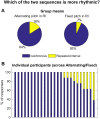Dance to the rhythm, cautiously: Isolating unique indicators of oscillatory entrainment
- PMID: 28926563
- PMCID: PMC5604934
- DOI: 10.1371/journal.pbio.2003534
Dance to the rhythm, cautiously: Isolating unique indicators of oscillatory entrainment
Conflict of interest statement
The authors have declared that no competing interests exist.
Figures

Comment on
-
Neural mechanisms of rhythm-based temporal prediction: Delta phase-locking reflects temporal predictability but not rhythmic entrainment.PLoS Biol. 2017 Feb 10;15(2):e2001665. doi: 10.1371/journal.pbio.2001665. eCollection 2017 Feb. PLoS Biol. 2017. PMID: 28187128 Free PMC article.
-
What do we talk about when we talk about rhythm?PLoS Biol. 2017 Sep 19;15(9):e2002794. doi: 10.1371/journal.pbio.2002794. eCollection 2017 Sep. PLoS Biol. 2017. PMID: 28926570 Free PMC article. No abstract available.
References
-
- Schroeder CE, Lakatos P. Low-frequency neuronal oscillations as instruments of sensory selection. Trends Neurosci. 2009; 32: 9–18. doi: 10.1016/j.tins.2008.09.012 - DOI - PMC - PubMed
-
- Large EW, Jones MR. The dynamics of attending: How people track time-varying events. Psych Rev. 1999; 106: 119–159.
-
- Breska A, Deouell LY. Neural mechanisms of rhythm-based temporal prediction: Delta phase-locking reflects temporal predictability but not rhythmic entrainment. PLoS Biol. 2017; 15(2): e2001665 doi: 10.1371/journal.pbio.2001665 - DOI - PMC - PubMed
-
- Obleser J, Henry MJ, Lakatos P. What do we talk about when we talk about rhythm? PLoS Biol. 2017; 15(9): e2002794 doi: 10.1371/journal.pbio.2002794 - DOI - PMC - PubMed
-
- Large EW, Snyder JS. Pulse and meter as neural resonance. Ann N Y Acad Sci. 2009; 1169: 46–57. doi: 10.1111/j.1749-6632.2009.04550.x - DOI - PubMed
Publication types
MeSH terms
LinkOut - more resources
Full Text Sources
Other Literature Sources
Miscellaneous

